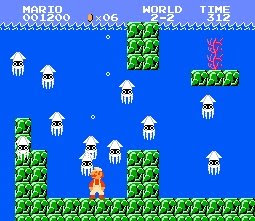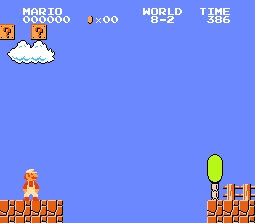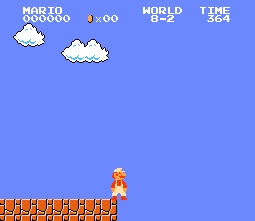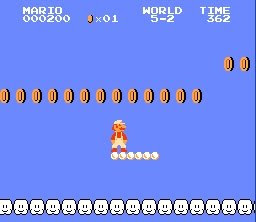While combing through Super Mario Bros. to write the Mario Melodies series, three topics/ideas/details in particular jumped out at me. I don't have enough material/time to expand these ideas into essays. So, it's that time again for a few "bullet point essays."
Mario Out of His Element

- The water levels in Super Mario Bros. are intricately designed to provide a different gameplay experience from the land levels while at the same time being familiar and complementary.
- While the land levels are about forward momentum/flow that is punctuated with spry vertical jumps, the water levels expand the verticality by giving the player access to the whole screen to swim through. Because the water is always pulling Mario downward, maintaining one's level or moving up is a constant struggle.
- In the water Mario sinks rather quickly, yet with a few pumps of his arms, Mario can float gracefully forward at a nice pace. Because the run button is disabled underwater and Mario's forward momentum is preserved (unless he runs into an object), players can get through the majority of the level with just the jump button.
- Just like how Mario can't jump downward on land, Mario depends on gravity to pull him downward underwater. This similarity links the gameplay of the land to the water so players can quickly become familiarize with the "jump" function even underwater. In essence, the "jump" mechanic can be further defined as "a push against gravity."
- To further contrast the land environment to the water, the aquatic enemies behave a little differently than the land enemies. The Cheep-cheep and Blooper can swim through the solid level elements.
- The Blooper is also one of the few enemies that actively approaches Mario. Though falling Buzzy Beetles, Paratroopa, and Lakitu do aim at mario's position by moving in the left or right direction, the Blooper is the only enemy that seeks Mario in 2 dimensions with the ability to turn around at any time.
- Moving through the water is slower than running on land. So, water levels inherently slow down the pace of the game. However, though Mario moves forward more slowly, there are this just as many factors to consider to keep the player engaged. Because the enemies can exist anywhere moving through the level elements, they intersect the available space for Mario to travel in interesting ways not commonly found on the land. Plus, the invisible underwater currents help make pits a threat to Mario.
Mario Looks Before He Leaps
- The screen scrolls in a way that positions Mario just left of the center. While moving forward the game maintains a space of 10 bricks in front of Mario and 5 bricks back. This allows the player to see more of what's coming up while still keeping an eye on what's being left behind.
- To give the game a positive forward moving flow, the developers never designed any dangerous enemy or level elements that the player must react to when the element is still out of view. In other words, everything the player needs to know in order to make informed decisions is always visible well before the player must make that decision.
- Somewhat hidden dangers like Piranha Flowers or fire balls reveal themselves to the player just as they come into view and before Mario has a chance to be hurt by them.
- The developers didn't create a jump that's too big for Mario to make. The distance of Mario's maximum run-jump is 9 bricks. If such a pit were to exist in a level, the player wouldn't even be able to see the end of it even when standing at the edge. See images above.
- For the gaps that Mario can't surmount, there is always an alternate path provided that's obvious and encouraged with careful coin placement.
- Mario's run ability increases his jump height and distance. At the same time, it makes it harder for Mario to reverse directions in the air and on the ground because of the extra momentum. For this reason, as the player increases the pace of their gameplay experience, the game difficulty ramps up.
- At higher speeds, the player has less time to react to oncoming dangers because of the increased scrolling speed and Mario's momentum. This is why jumping is an ideal strategy for avoiding oncoming threats when running. Jumping not only preserves the running speed, but it's what the game is all about.
Coins: Gotta Catch Them All
- The coins in Super Mario Bros have a variety of functions.
- Gathering 100 gives the player a 1up.
- Their placement can encourage jumping without needing to create threatening situations.
- Coins placed in difficult and tricky spots allow the player to adjust the challenge of their gameplay experience on the fly. Those who want a bigger challenge go after the more dangerous coins.
- Miyamoto scolded the level designers for Super Mario Galaxy upon viewing an early build of a level that was littered with coins. With so many coins, the focus of the level became cluttered and the coins lost their ability to encourage players. This issue was fixed immediately.
- In Super Mario Bros. coins are pure. They will never hurt Mario, and they are always put in places where Mario can safely obtain them.
- Coins are used to encourage players to explore, and jump in ways that are not necessary to complete the level. It's important to understand that all the previous functions are only possible because of two reasons. 1) There is never a coin positioned in a place that Mario must travel. If that were to happen, the function of the coin would be diminished. If the player must move to a specific location to progress, when putting a coin there would be similar to charity. 2) There is never a coin that Mario can't grab safely. If either of these rules were to be broken, then coins would turn into wild cards/taunts that force the player to doubt each coin.
- There's a third parameter that the developers followed to ensure the purity of the coin's function. If a player sees coins (assuming the player is at least Big Mario), then they should be able to obtain all of the visible coins. This parameter when followed, reinforces all of the coins functions. Every coin must communicate to the player, "You can get me," so that their collective presence says "Gotta catch us all."



